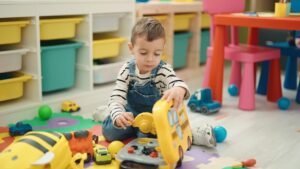Children are naturally curious. From the moment they begin to explore their surroundings, they ask questions, test boundaries, and try to make sense of the world around them. At The Step by Step School, we believe that curiosity is the foundation of learning—and when nurtured correctly, it blossoms into confidence and independent thought. Encouraging children to think for themselves helps them develop problem-solving skills, creativity, and resilience that will serve them for life.
In Hoboken and beyond, parents and educators play a vital role in guiding this process. By creating environments that invite exploration and allow for mistakes, adults help young learners grow from inquisitive observers into confident thinkers.
Why Independent Thinking Matters
Independent thinking isn’t just about making decisions—it’s about understanding how to learn, reason, and explore without fear of failure. When children are encouraged to think independently, they gain the tools to approach challenges with confidence rather than hesitation.
For young learners, these early lessons are essential. They help children form opinions, express ideas, and build confidence in their own capabilities. This confidence fuels a lifelong love of learning and prepares them for both academic and personal success.
In classrooms across Hoboken, schools like The Step by Step School focus on child-led activities that empower students to ask “why” and “how.” This approach not only deepens understanding but also builds self-assurance and critical thinking from an early age.
Encouraging Curiosity Through Exploration
Every great thinker started as a curious child. Curiosity is the spark that leads to discovery—and in education, it’s the heartbeat of meaningful learning. Encouraging exploration in young children doesn’t require complicated tools or lessons. It starts with giving them the freedom to ask questions and the space to find answers.
Simple activities like nature walks, sensory play, or experimenting with art materials help children explore cause and effect, learn patience, and develop creative problem-solving. When a child builds a tower of blocks and watches it fall, they’re learning about balance and persistence—key components of independent thinking.
At The Step by Step School, educators use play-based learning to harness this curiosity, turning each moment into an opportunity for growth and self-discovery.
Building Confidence Through Small Successes
Confidence grows from achievement—but even small victories matter. When children are encouraged to try new things, make mistakes, and learn from them, they begin to see challenges as opportunities rather than obstacles.
Parents can nurture this growth at home by celebrating effort instead of perfection. Phrases like “You worked so hard on that!” or “I like how you tried a new way!” reinforce the idea that success comes from persistence and creativity, not just right answers.
In Hoboken’s fast-paced environment, finding moments to slow down and celebrate progress helps children develop resilience and self-esteem, both of which are essential for independent learning.
The Role of Play in Independent Thinking
Play is the most natural way for children to learn. Through imaginative play, building, or role-playing, they practice decision-making, empathy, and problem-solving—all while having fun.
For example, when children play “pretend school” or “grocery store,” they’re learning how to organize, negotiate, and communicate effectively. These activities teach them how to make choices and solve problems independently.
At The Step by Step School, teachers create play-based environments where children take the lead in their learning. This freedom to explore builds a strong sense of ownership and confidence that will benefit them long after preschool.
Creating Environments That Inspire Independence
A key component of encouraging independent thinking is providing environments that invite exploration. A clutter-free, organized, and safe learning space gives children the freedom to make choices and learn at their own pace.
Parents can apply this principle at home by offering child-friendly spaces where kids can engage in creative activities—like a small reading nook, an art corner, or a space for building blocks. Giving children the autonomy to choose what to play with encourages self-direction and initiative.
Hoboken parents who visit The Step by Step School often notice how thoughtfully designed classrooms allow children to explore safely and confidently—a reflection of how environment shapes learning behavior.
Encouraging Problem-Solving and Decision-Making
Independent thinking thrives when children are given opportunities to make decisions. Instead of solving every problem for them, parents and teachers can ask guiding questions like, “What do you think we should try next?” or “Why do you think that happened?”
This approach encourages analytical thinking while showing children that their ideas are valued. It helps them learn how to evaluate situations, consider options, and find solutions on their own.
As children navigate daily challenges—whether building a puzzle or managing emotions—they develop the cognitive flexibility and self-control that are cornerstones of lifelong learning.
Supporting Independent Thinking Through Collaboration
While independence is important, collaboration teaches children how to think collectively and appreciate different perspectives. Working in pairs or small groups encourages teamwork, listening, and empathy.
At The Step by Step School, collaborative learning activities help children learn from one another. When students share their ideas, they not only validate their own thinking but also become open to new ways of understanding.
Parents can encourage this at home by organizing group playdates or cooperative games where children practice patience, communication, and respect—skills that support independent and confident thinking.
Balancing Guidance and Freedom
Encouraging independent thinking requires balance. Too much control can stifle curiosity, while too much freedom can lead to frustration. The goal is to guide, not dictate.
Parents and educators should act as facilitators—providing structure when necessary but allowing space for creativity and exploration. Setting simple, clear boundaries helps children feel secure while still empowering them to take initiative.
For example, offering two or three choices (“Would you like to read or draw?”) gives children a sense of control within a safe framework. This balance nurtures both independence and confidence.
The Role of Emotional Support in Building Confidence
Children who feel emotionally supported are more willing to take risks in learning. They know that mistakes won’t result in criticism but in encouragement. When adults respond with empathy and patience, children develop resilience and self-assurance.
At The Step by Step School, emotional development is a key part of academic growth. Teachers build trust and connection with every child, ensuring they feel seen and valued. This emotional foundation gives young learners the confidence to explore independently and learn from experience.
Parents can reinforce this by offering reassurance during challenging moments—turning setbacks into lessons about perseverance and courage.
Encouraging Independent Thinking in Hoboken Families
Families in Hoboken have unique opportunities to extend classroom learning into daily life. Visiting local museums, parks, or community events gives children real-world experiences that encourage curiosity and independent thought.
For example, during a trip to the Hoboken waterfront, parents can ask their child to describe what they see or guess how boats float—sparking inquiry and conversation. These small moments cultivate the same independent thinking that The Step by Step School promotes every day.
For more personalized guidance on nurturing confidence and curiosity in your child, contact The Step by Step School. You can also find the school’s location and reviews on Google Maps.
Conclusion
Independent thinking is one of the greatest gifts we can give children. By nurturing curiosity, building confidence, and allowing space for exploration, parents and educators help young learners develop the skills they need to succeed in school and in life.
At The Step by Step School, every child is encouraged to explore, question, and create—turning their natural curiosity into a lifelong love for learning. If you’re a Hoboken parent looking to inspire independence and confidence in your child, reach out today to learn how our programs support self-motivated learning from the very beginning.
FAQs
1. Why is independent thinking important for young learners?
Independent thinking builds confidence, creativity, and problem-solving skills—helping children approach challenges with curiosity and self-assurance.
2. How can parents encourage independent thinking at home?
Provide choices, encourage exploration, and ask open-ended questions that allow children to think and respond freely.
3. What role does curiosity play in developing independent thinking?
Curiosity drives exploration, experimentation, and discovery—all of which strengthen critical thinking and learning independence.
4. How does The Step by Step School promote independent thinking?
Through play-based learning, exploration, and child-led activities, teachers help children take ownership of their learning journey.
5. How can Hoboken families support independent learning outside the classroom?
Hoboken offers parks, libraries, and community spaces where parents can extend classroom learning through real-world exploration.









